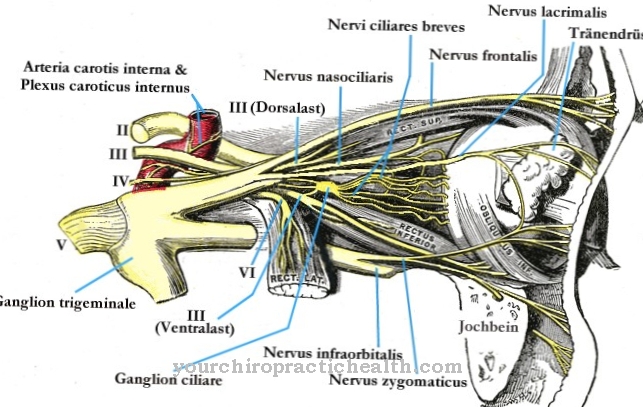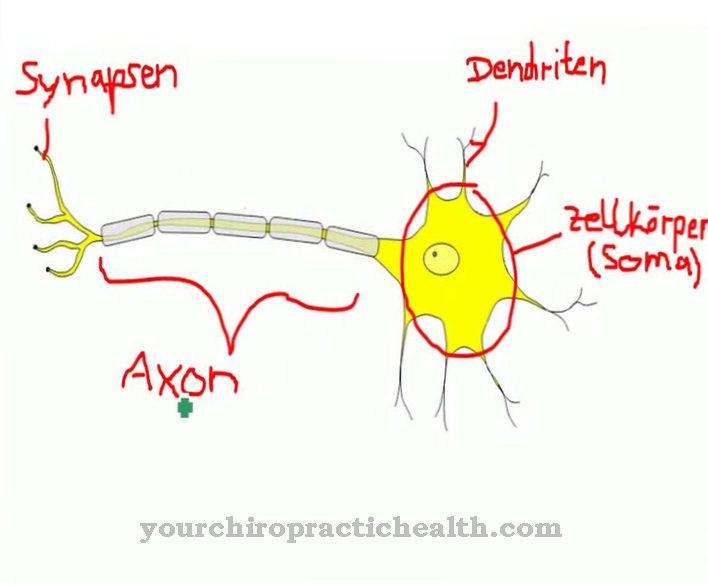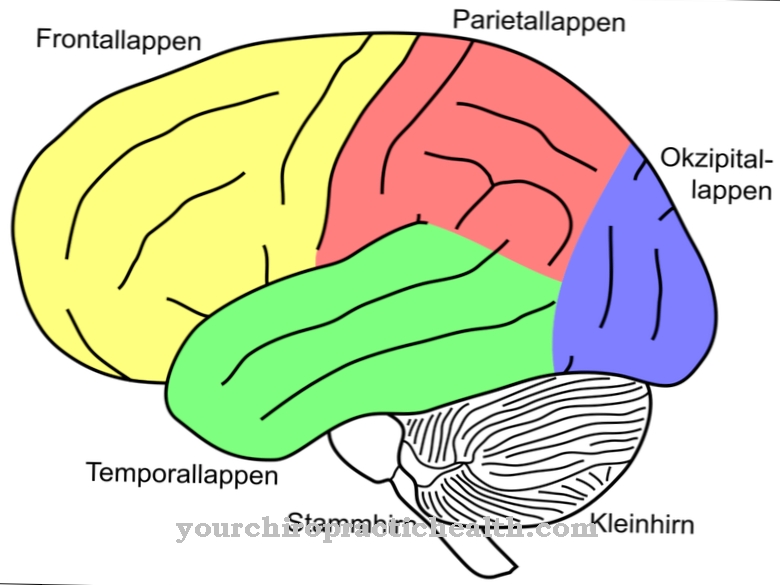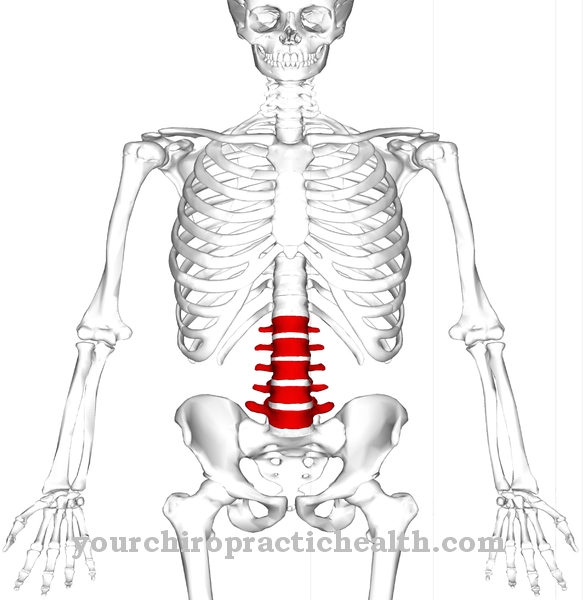The Eyelashes are small, curved hairs that are found in mammals on the upper and lower lids of the eyes.
What are eyelashes?
As well as the hair on the head, beard and eyebrows belong to the Eyelashes, Latin Cilia, to the appendages of the skin. The finely curved and elastic hairs on the edge of the eyelid fulfill important protective functions and have been of great aesthetic importance for people for centuries.
Anatomy & structure
Eyelash hair consists mainly of keratin, the skin's own horny substance. Keratin is a collective term for water-insoluble, amino acid-containing fiber proteins.
These firm, elastic fibers are made up of keratinized, dead cells, the keratinocytes. The stiff, short bristle hairs (terminal hairs) of the eyelashes are surrounded by sebum and sweat glands. The melbom glands and the Zeis glands are sebum glands and produce what is known as "eye butter", a secretion that prevents tear fluid from overflowing.
Eyelash hairs have a lifespan of around 100 - 150 days. Then these fail and regenerate again. The human eyelash growth cycle lasts anywhere from 4 weeks to 6 months. The majority of the eyelash hair is constantly in its growth phase - only 10 percent of all eyelash hair is in the final growth process.
The upper edge of the eyelid comprises a thick lash line of around 150-250 hairs. At the lower edge of the eyelid, the eyelashes with 50 - 150 hairs grow significantly sparse. The upper and lower lash line also differ in length growth: the average length of the eyelash hair is 8 - 12 mm at the top and only 6 - 8 mm at the bottom. Normally, the hair color of the head and the color of the lashes are identical - individually defined by the proportion of the body's own hair color pigment, melanin.
Function & tasks
The eyelashes fulfill important protective functions of the eye against sweat, dust, dirt particles and small foreign bodies. They also protect the eye from intense UV radiation. American scientists have found in studies on various mammals that these have a very similar geometric eyelash shape - depending on the size of the eye.
Their conclusion: Long eyelashes have significant aerodynamic disadvantages compared to short eyelashes. Due to their length, they defy air resistance badly and promote a high absorption of dirt particles. Long eyelash hairs allow the eye to dry out faster.
Despite the controversial medical health aspects, long, silky and beautifully curved eyelashes have been an essential beauty criterion since ancient times. Cosmetic eyelash care products, herbal growth preparations and eyelash colors for women and men were already used regularly in ancient times.
While long, black, strong and thick eyelashes were on the one hand très chic, a highly erotic seduction symbol, on the other hand there was a total shave of facial hair, which was considered attractive. In ancient Egypt, high priests shaved off all body hair, including the eyelashes and brows, as an outward sign of their belonging to the caste. Even today, eyelash emphasis is subject to a multitude of fashion aspects as well as ethnic and cultural influences.
You can find your medication here
➔ Medicines for eye infectionsIllnesses & ailments
In addition to total eyelash loss (madarosis) or eyelash breakage, there are a number of eyelash dysfunction that can develop into serious damage if left untreated. Pathological changes in the position of the eyelids lead to trichiasis, a misalignment of the eyelashes with mechanical irritation of the cornea.
Eyelid skin diseases are, for example, pigment disorders, fat deposits (xanthelasma), herpes simplex infections and other cosmetically disturbing skin inflammations, which in turn can cause persistent hair loss.
Inflammation of the sebum glands, such as the stye, or the chronic inflammation of the meibomian glands, the hailstone (chalazion), should definitely be treated by a specialist. Painful eyelid margin diseases (blepharitis) are often associated with infectious conjunctivitis. Another medical indication for eyelash loss is parasitic attack on the eyelids.
If the lash color and hair structure suddenly change, genetic, metabolic or nutritional disorders can be the cause. Lash loss is observed particularly in the case of stress, significant vitamin deficiencies, hormone fluctuations and cancers with intensive chemotherapy or radiation therapy as well as after burns.
However, incorrect make-up techniques, overdosed or incompatible care products and an overly aggressive or even completely neglected daily make-up removal ritual are also triggers for alarming eyelash loss or breakage.
The permanent and improper use of mechanical beauty tools, such as eyelash curlers, and constant eyelash tinting in the beauty salon are further risk factors. The cosmetics industry now offers various ophthalmologically and dermatologically tested growth serums against thinning eyelashes.
Anyone who suffers from acute eyelash loss often has a long odyssey of time-consuming and cost-intensive treatments and product applications behind them. When conventional methods no longer help, the only option is often to go to the cosmetic surgeon.
New procedures in transplant practice, such as the modern I-FUE procedure, provide a remedy. With eyelash transplantation using the I-FUE method, eyelash thickening and eyelash lengthening are equally possible on the upper and lower eyelids. Depending on the hair density and hair structure, about 80 - 150 donor hairs are transplanted.
In total hair loss, up to 300 grafts are placed in the hair follicles. The use of scalp hair also offers visual advantages through strong, hair structure-identical length growth. The transplantation procedure has been tried and tested worldwide and is considered to be a skin-friendly, painless alternative to the conventional strip technique.
Further advantages: The I-FUE technique does not require the use of a scalpel or sutures and does not leave any unsightly scarring. In addition, the procedure does not require a long hospital stay. Hair removal takes about 30 minutes, and precise insertion into the hair follicle about 45 minutes. Satisfied patients confirm a high growth rate of the transplanted donor hair and a minimal risk of injury. In 95 percent of the treated patients, the transplanted eyelash hairs grow back healthy and normal.
























.jpg)



